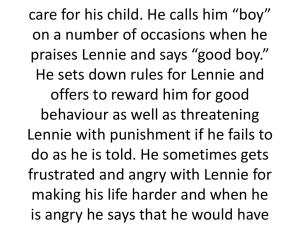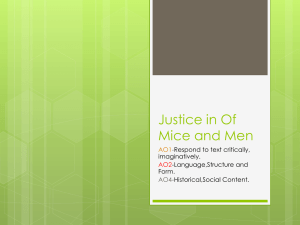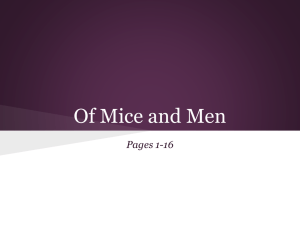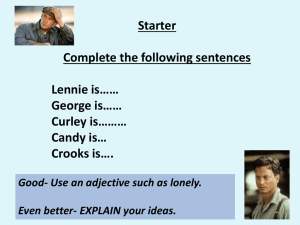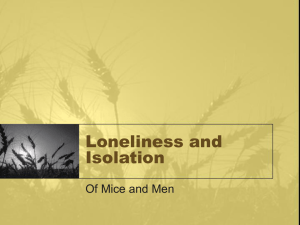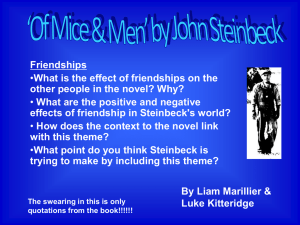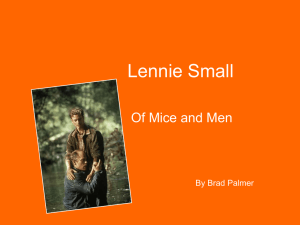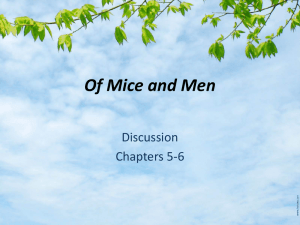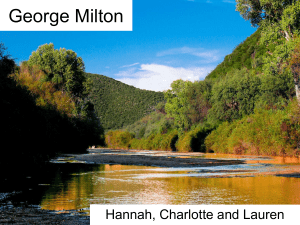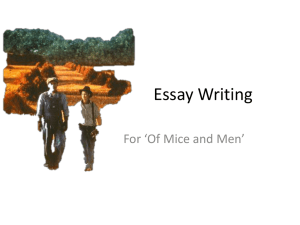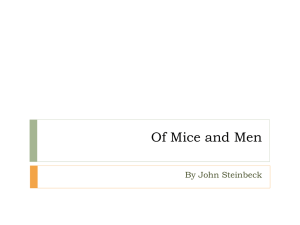Of Mice & Men - St James School
advertisement
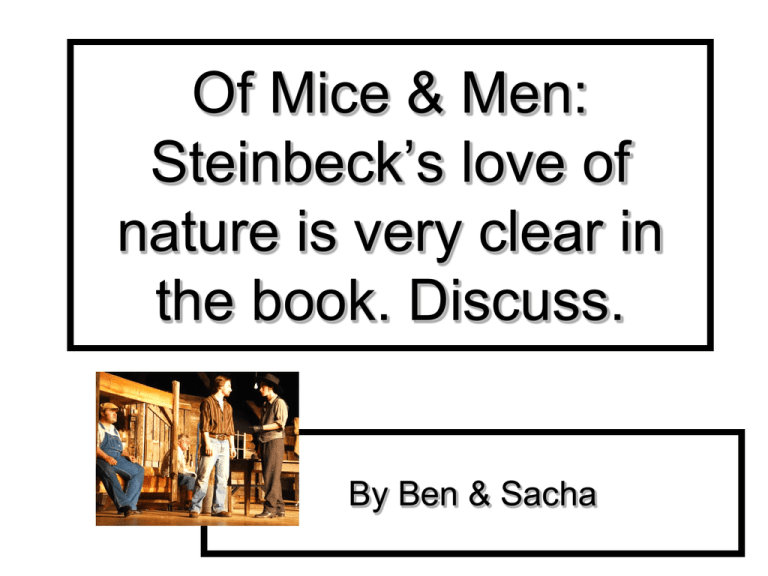
Of Mice & Men: Steinbeck’s love of nature is very clear in the book. Discuss. By Ben & Sacha Steinbeck shows the world of nature to be a beautiful and peaceful one, but threatened by the actions of men. When the book opens, the scene described is a very peaceful , calm and beautiful one. “…the Salinas River drops in close to the hillside bank and runs deep and green. The water is warm too, for it has slipped twinkling over the yellow sands in the sunlight before reaching the narrow pool. On one side of the river the golden foothill slopes curve up to the strong and rocky Gabilan Mountains, but on the valley side the water is lined with trees—willows fresh and green with every spring…”. Everything has it’s place and is untouched and unspoilt. However, as the description continues we see where man has made its mark on nature, and not necessarily in a positive way. “There is a path through the willows and among the sycamores, a path beaten hard by boys coming down from the ranches to swim in the deep pool, and beaten hard by tramps who come wearily down from the highway in the evening to jungle-up near water. In front of the low horizontal limb of a giant sycamore there is an ash pile made by many fires; the limb is worn smooth by men who have sat on it.” The beginning of the novel sets this pattern, as the creatures at the pool are disturbed by George and Lennie's approach. “Evening of a hot day started the little wind to moving among the leaves. The shade climbed up the hills toward the top. On the sand banks the rabbits sat as quietly as little gray sculptured stones.” Up until this point, everything is peaceful and calm. The animals are in control, they are in their natural habitat and are peaceful and calm. Then… “And then from the direction of the state highway came the sound of footsteps on crisp sycamore leaves. The rabbits hurried noiselessly for cover.” This is an expression that people use when they’re running from a bomb or an explosion – they run for cover – which implies that man can cause a lot of damage to nature. “A stilted heron labored up into the air and pounded down river. For a moment the place was lifeless…” Steinbeck obviously feels that nature is alive, and it is the animals that create this feeling, so without them nature dies. “…and then two men emerged from the path and came into the opening by the green pool. They had walked in single file down the path…” The ranch and its buildings, being created by men, are in contrast with the natural world. Notice that the bunkhouse, for example, is quite bare and stark. “…the Salinas River drops in close to the hillside bank and runs deep and green. The water is warm too, for it has slipped twinkling over the yellow sands in the sunlight before reaching the narrow pool. On one side of the river the golden foothill slopes curve up to the strong and rocky Gabilan Mountains, but on the valley side the water is lined with trees— willows fresh and green with every spring…”. Compare the colours: golden, green vs. black, white (washed). The natural world is vibrant and colourful, the manmade one plain and unexciting. Twinkling vs. solid. Unpainted vs. sunlight “The bunk house was a long, rectangular building. Inside, the walls were whitewashed and the floor unpainted. In three walls there were small, square windows, and in the fourth, a solid door with a wooden latch. Against the walls were eight bunks…Near one wall there was a black cast-iron stove, its stovepipe going straight up through the ceiling. In the middle of the room stood a big square table littered with playing cards…” If the natural world is described as a beautiful place, the men in it are described as the opposite. “They had walked in single file down the path, and even in the open one stayed behind the other. Both were dressed in denim trousers and in denim coats with brass buttons. Both wore black, shapeless hats and both carried tight blanket rolls slung over their shoulders. The first man was small and quick, dark of face, with restless eyes and sharp, strong features. Every part of him was defined: small, strong hands, slender arms, a thin and bony nose. Behind him walked his opposite, a huge man, shapeless of face, with large, pale eyes, and wide, sloping shoulders; and he walked heavily, dragging his feet a little, the way a bear drags his paws. His arms did not swing at his sides, but hung loosely.” Words like pale, black, shapeless make them seem inhuman. Their actions – dragging, heavily, hung loosely – imply little energy or life – whereas the natural world is alive and twinkling. If the natural world is described as a beautiful place, the men in it are described as the opposite. And no more so than Candy and Crooks who are both deformed or unnatural in appearance. Candy: “…a tall, stoop-shouldered old man came in…He pointed with his right arm, and out of the sleeve came a round stick-like wrist, but no hand.” Crooks: “His body was bent over to the left by his crooked spine, and his eyes lay deep in his head, and because of their depth seemed to glitter with intensity. His lean face was lined with deep black wrinkles, and he had thin, pain-tightened lips which were lighter than his face.” Compared to the vibrant and alive natural world, Crooks and Candy seem like the complete opposite. Their bodies are broken, certainly not beautiful and they aren’t able to move freely and easily like the natural world can. Contrasted to these two characters is Lennie, who almost seems a part of the natural world as he is often compared to animals by Steinbeck in the book. “Lennie dabbles his big paw in the water and wiggled his fingers so the water arose in little splashes” “Drank with long gulps, snorting into the water like a horse”, These two quotes show that Lennie doesn’t have any expression on his face and is huge. The way he says “paw” says he’s massive like a bear, the kind of person you wouldn’t want to approach. Steinbeck used these particular animals because they’re big, and strong. A bear can take life, like Lennie does. Steinbeck uses animals to foreshadow the events of the book The animals in the book have a very important role as they foreshadow the events that happen at the end of the book. This shows that at the end of the day we are all the same; nature and man; and that we meet the same fate. Steinbeck describes nature much more positively then man, but obviously sees nature as equal to man in some respects because their death is the same. The killing of the mouse and the puppy foreshadows the death of Curley’s Wife: these innocent creatures, that have soft hair that Lennie likes to touch, all die at Lennie’s hands when he is petting them. The shooting of Candy’s Dog foreshadows the shooting of Lennie. In both cases the creatures are put out of their suffering (that which is to come in Lennie’s case). They are both killed in exactly the same way, and George learns from Candy’s mistake and makes sure he shoots Lennie himself rather than letting someone else do it. Animals play a large role in the work of the ranch; without them the ranch wouldn’t run. Horses are used to pull the machinery on the farm and the trailers that collect all the hay and barley that has been picked. Crooks role is to look after the horses, so the fact they have one person dedicated to look after them shows how important they are: “Crooks had his apple box over his bunk, and in it a range of medicine bottles, both for himself and for the horses.” Animals are also the companions of a lot of the men. Crooks spends a lot of time with his horses, Candy has his dog, Slim has a dog too. ““Look, Slim’s bitch got a litter right now. I bet Slim would give you one of them pups to raise up, wouldn’t you, Slim?” The sign of a good worker is how well he can work with the animals. This is why Slim is the “Prince of the ranch” because “He was a jerkline skinner, the prince of the ranch, capable of driving ten, sixteen, even twenty mules with a single line to the leaders. He was capable of killing a fly on the wheeler’s butt with a bull whip without touching the mule.” Nature is seen as a place of safety in the book. The natural world is portrayed as a safe place because George always says to Lennie to go back too the brush if anything ever goes wrong: “Well, look. Lennie—if you jus’ happen to get in trouble like you always done before, I want you to come right here an’ hide in the brush.” Because Lennie feels safe there he even considers living there when he threatens to go off and live in a cave: “He turned his head and looked at the bright mountain tops. “I can go right off there an’ find a cave,” he said. And he continued sadly, “—an’ never have no ketchup—but I won’t care. If George don’t want me . . . . I’ll go away. I’ll go away.” The brush is also where Lennie dies and this seems right because it is a place Lennie remembered and a place where he felt safe: “And George raised the gun and steadied it, and he brought the muzzle of it close to the back of Lennie’s head. The hand shook violently, but his face set and his hand steadied. He pulled the trigger. The crash of the shot rolled up the hills and rolled down again. Lennie jarred, and then settled slowly forward to the sand, and he lay without quivering.”
